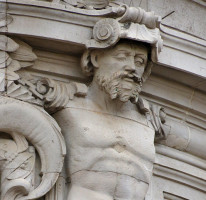
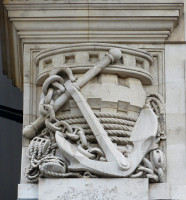
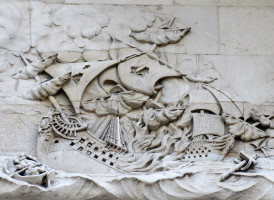
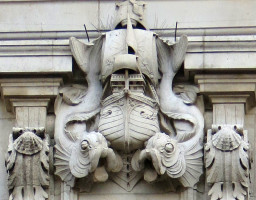
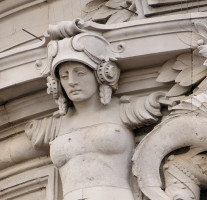
Deptford, near Greenwich and Woolwich in South London, has one of the more decorative and flamboyant Edwardian town halls on the smaller scale. It is in the Edwardian Baroque style, and is by the excellent architectural partnership of Lanchester, Stewart and Rickards, with the architectural sculpture by Henry Poole. It was completed in 1905.
Deptford Town Hall, as it is (left), unchanged from when it was put up (centre), and plan (right).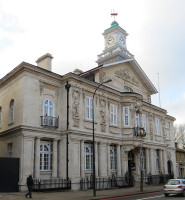
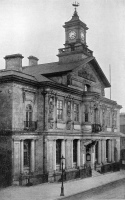
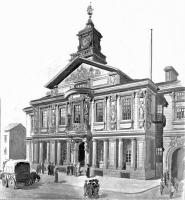
The building (which incidentally is now owned by Goldsmiths' College) is close to New Cross Gate Underground Station, on New Cross Road. It is a fair size for a London town hall, but achieves an effect of grandeur beyond its physical dimensions. The building is seven bays wide, and mostly two storeys high, though their height is extremely generous, and the ground floor bays have Doric pillars to each side. The central portico, arched, is up several steps, and has a prominent bay window on the floor above it. Above that is a central third storey, or wide tower with gabled roof, and on that is a small square clock tower with balcony around it and a concave-sided little steeple on that, bearing a weathervane. The building is almost symmetrical, but the right hand side has an arched door at ground level, presumably to allow entrance to some yard behind, or at least the movement in and out of bulky deliveries; this bay lacks the side pillars. There is an iron fence in front, and a basement storey of which the tops of the arched windows are visible from across the street at ground level. And there is a lot of decorative sculpture.
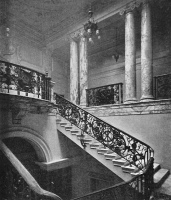
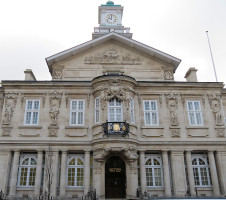 View of interior staircase, and principal sculpture on frontage.
View of interior staircase, and principal sculpture on frontage.
The theme of the sculpture is nautical, and this is reflected on every level of the building. Thus on the ground floor, the central portico has two Tritons leaning over it, acting as supports, thus Atlantes (male supporting figures, the equivalent of the more familiar Caryatid – see this page; for more on Tritons, see this page). They have excellently long, sinuous tails complete with fins. The arms vanish into the architecture, with further fins. Unusually, these Tritons also have wings. Between them, the iron grill above the door includes two seahorses.
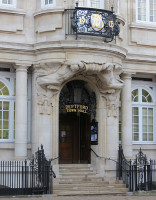
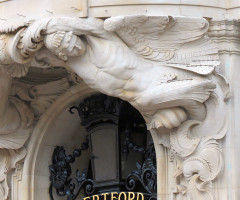 Portico, and detail of one of the Tritons.
Portico, and detail of one of the Tritons.
There is an arch to the right hand side of the building as we look at it, and in the keystone position is a coat of arms. In the centre, a cartouche with low relief carvings of three birds, a ship in dry dock, a make figure with crown above his head, and a rampant horse. To left and right are upward-pointing tridents, each with an eel coiled around its shaft, and to left and right of those are large, scaly and gasping fishes; another fish stares out from above (if you like fish sculpture, see this page). Finally, at the base of the keystone is a crab, and behind and around all is splendidly carved seaweed of the bladder-wrack kind. Excellent decorative work.
Statues of Robert Blake, Francis Drake, Nelson and 1905 admiral.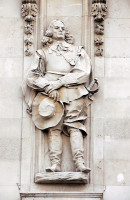
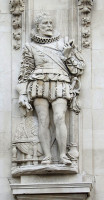
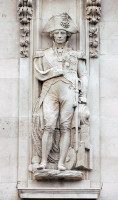
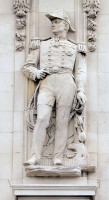
Moving upwards, the first floor contains the principal sculpture: four full sized statues of Naval heroes: Francis Drake, Robert Blake, ‘father of the Royal Navy’, Nelson, and some modern (1905) figure who is meant to be typical rather than any specific person.
Robert Blake, dated 1652: this was the year when the first Anglo-Dutch war broke out, and Blake inflicted early defeats on the Dutch, before himself being defeated (at odds of 80:40 ships though), which led him to review the English fleet and write the first Fighting Instructions to the commanders of his fleet, underpinning his resounding defeat of the Dutch the following year. A rather Cromwellian figure, with broad-brimmed hat, wide sleeves with large turned-back cuffs, leather boots with the tops turned over, and flowing locks of hair; a noble figure indeed. He wears a fencing sword hanging behind him, and has no other accoutrements.
Nelson, 1805 – the date refers to the Battle of Trafalgar of course, when Nelson and the now British fleet defeated the combined French and Spanish fleet, sinking 22 ships without losing a single British ship. Nelson has his trademark empty sleeve pinned to his front, wears his tricorn hat, and a chestful of medals. Behind him is crowded: a mounted cannon and cannonballs, and some rigging or net. For Nelson's Column, see this page.
The 1905 figure: a suitably severe, determined looking character, with medal and what seems to be a Primrose League cross, sword not so different from Robert Blake’s, Edwardian jacket, trousers and shoes. Behind him, coils of rope and some pulley, a chain, and perhaps a rudder.
Above each figure is the prow of a ship, flanked by two large, decorative fish, and down the sides are a mix of seaweed-like acanthus leaves, and various shells, nicely varied.
Views of the central decoration with ship and half-figures etc.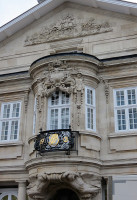
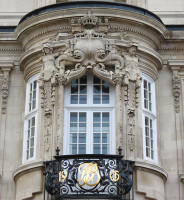
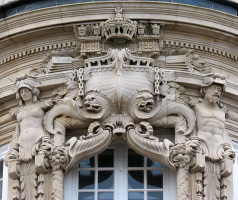
The central bay between these four figures has a balcony railing with the date 1905, a monogram seemingly containing a D for Deptford – perhaps London Borough of Deptford (?) and nice curly branches etc. At the top of this central portion is further sculpture: the prow of a ship with many oars and a forecastle with four lamp and a central projection almost like a crown, two curled, grotesque fishes, and a pair of cornucopia. As side supporters, there are a pair of steles, or partial figures, male and female, of which we have the head and helmet, a torso, and then architectural elements proportionate to the heights of the figures; they could be called Caryatid and Atlantes in their own right. The male is a muscular, bearded fellow with the powerful neck and chest of a river god, his companion combines a Valkyrie face with chiselled features, plaited hair and heavy neck with a more curvy, feminine torso. Given the combination of limbless nude torso, helmeted head, architectural features, ship prow, chains, fishes etc, the whole manages a remarkable unity and appropriateness.
Deptford Town Hall pediment sculpture of a naval battle.
Above, rises the central tower. At entablature height on the corners are carved squares containing large anchors, chains and coils of rope and tackle, well sized for the height above ground. The pedimental sculpture, again in high relief, is more difficult to fully grasp from ground level, as it is a full naval battle between tall ships, but is helped by completely removing the outer rim, so that the sculpture protrudes rather than, as is normal in a pediment, being recessed; the upper edge of the roof is a goodly distance above. From the ground, we can still immediately distinguish the central ship, three masted and many-cannoned. There seem to be at least eight other ships, several with plumes of smoke, one sinking and in flames, and with a lifeboat moving towards the front. The detail is remarkable, and cannot be properly seen from ground level without visual aid: the detail of the decoration on the prows including a figurehead, the rigging, the sails with cannonball holes torn in them, and the farthest ships jockeying for position in the background (click on the picture to enlarge and see all this) – all was clearly done for the sheer enjoyment of the sculpture. Finally, above all rises the little clock tower, with a ship weathervane, nicely silhouetted against the sky.
Henry Poole, the sculptor, is much associated with architectural carving, and his most familiar work in London is probably the decorative sculpture on Methodist Central Hall facing Westminster Abbey, also for Lanchester and Rickards. Their most prominent work, also with sculpture by Henry Poole along with other sculptors, is Cardiff City Hall, on monumental scale.
We end by noting that just along the road from the Town Hall, no.323 New Cross Road is a rather splendid Victorian pub, now called New Cross Inn. Three storeys high with a little tower, the vaguely Queen Anne style building has a variety of relief sculpture higher up, including a few birds and beasts as grotesques (i.e. entirely subordinate to the design). Just above the ground floor are several half-figures as termini above the pilasters, male and female, each being a head, shoulders and torso, dissolving at about navel level into architectural ornament, and with stubby wings rather than arms. Most ornamental.
323 New Cross Road nearby, and decorative detail.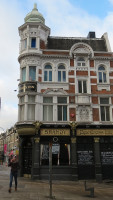
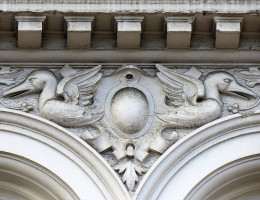
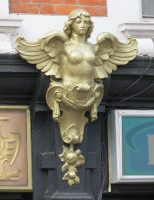
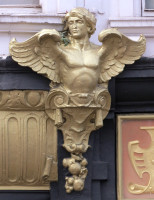
Another decorated town hall, at Shoreditch // and at Woolwich // and at Bermondsey
Also in Deptford: St Nicholas Church, Deptford // and St Paul's Church, Deptford
Visits to this page from 2 February 2015: 9,937